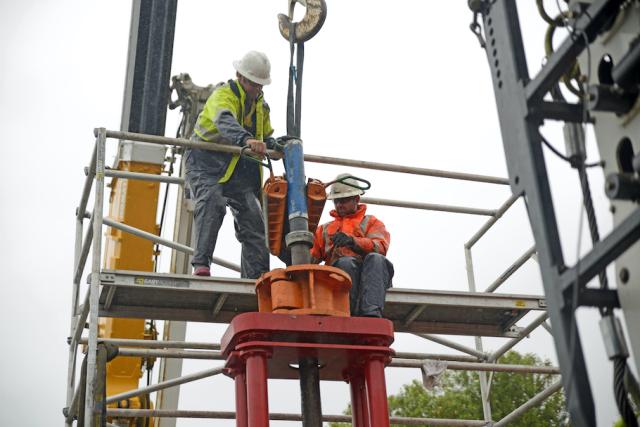
Engineers work in the rain to remove the steel casing from an oil well that is being plugged and abandoned. (Source: Lakeview Images/Shutterstock.com)
Presented by:

Editor's note: This column appears in the new E&P newsletter. Subscribe to the E&P newsletter here.
Perhaps you’ve noticed lately an increased level of attention to the abandonment of old oil and gas wells and, like me, are wondering what is driving it. I'm aware of a few teams that have formed organizations (both for-profit companies and not-for-profit organizations) to properly plug old wells and reclaim the well locations; a couple of examples are P&A Exchange and Fellow Environmental Partners. Anecdotally, I've heard of some other teams that may be preparing to enter the space, and all these are in addition to those that were already involved.

Unplugged and improperly plugged wells are a significant problem in Texas, Louisiana and other hydrocarbon-producing states. A recent article published by S&P Global Platts delves into the issue and states that Texas has about 6,200 orphaned wells (i.e., unplugged wells that were owned by companies that are no longer solvent). The number has the potential to grow, however, due to an estimated 37,000 unplugged wells that have been inactive more than a decade and about 150,000 inactive wells overall. Texas has a state-run program to abandon orphaned wells and is currently plugging about 1,800 per year.
Although the problem of orphaned wells isn’t new, there does seem to be increased interest in addressing it. This is likely due to a couple of factors. First, and probably most importantly, legislation being negotiated in Washington as part of infrastructure and jobs bills includes significant funds for the abandonment of old wells and mines. Although the legislation isn't final, the numbers being considered are several hundred million dollars per year. Not only would these funds protect the environment by preventing the movement of hydrocarbons and saltwater to freshwater aquifers in unplugged wells, but they would also provide a source of jobs for oilfield workers who have been impacted by the recent downturn in drilling activity.
Another proposed benefit of the legislation is that plugging inactive wells would reduce the amount of methane released into the atmosphere. According to a brief study by Resources for the Future, using the potential $4.7 billion proposed funding in the draft Energy Infrastructure Act to plug 62,000 inactive wells over 10 years would result in an emissions reduction of 18.6 million metric tons of CO2e over 50 years. While that adds to the positive benefit of plugging inactive wells, it is not a very economical means of emissions reduction since it implies a cost of $250 per ton of CO2e.
The increased attention on ESG metrics is another reason the industry is focusing more on proper and timely well abandonment. It is no secret that the upstream industry has received a lot of criticism lately, and that has had an impact on the willingness of some investors to continue to fund oil and gas activities. It makes sense then for the industry to be more proactive in being good stewards of the land on which they operate.

Most oil-producing states require operators to plug and abandon wells relatively soon after they cease production. States may grant extensions to plugging timing, however, for a variety of reasons. For example, plugging a well in Texas can be delayed for five years if the operator files an Abeyance of Plugging Report prepared by a licensed engineer or geoscientist that states the well has a “reasonable expectation of economic value” above its plugging costs, a reasonable expectation that it will be returned to production and documentation that demonstrates the well’s future utility.
Unlike fine wine, inactive oil and gas wells don’t get better with age. It would be interesting to examine how many of the wells that were granted plugging extensions were ultimately returned to production and compare that to the number of wells that were eventually orphaned to ensure the right to an extension was not misused. Either way, it’s good to see the industry increasing its attention to the proper and timely plugging of wells that are no longer producing.

About the author: Steve Hendrickson is the president of Ralph E. Davis Associates, an Opportune LLP company. With more than 35 years of professional leadership experience in the energy industry, he has a proven track record of adding value through acquisitions, development and operations. A licensed professional engineer in Texas, he earned an M.S. in finance from the University of Houston and a B.S. in chemical engineering from The University of Texas at Austin. Hendrickson recently served as a board member of the Society of Petroleum Evaluation Engineers and is a registered FINRA representative.
Recommended Reading
McDermott Consortia Scoops Up Two Ruya Project Contracts
2024-02-01 - The EPCIC contracts support the expansion of the offshore Al-Shaheen Field, Qatar’s largest oil field.
E&P Highlights: April 1, 2024
2024-04-01 - Here’s a roundup of the latest E&P headlines, including new contract awards.
E&P Highlights: Jan. 29, 2024
2024-01-29 - Here’s a roundup of the latest E&P headlines, including activity at the Ichthys Field offshore Australia and new contract awards.
Deepwater Roundup 2024: Offshore Australasia, Surrounding Areas
2024-04-09 - Projects in Australia and Asia are progressing in part two of Hart Energy's 2024 Deepwater Roundup. Deepwater projects in Vietnam and Australia look to yield high reserves, while a project offshore Malaysia looks to will be developed by an solar panel powered FPSO.
Deepwater Roundup 2024: Offshore Africa
2024-04-02 - Offshore Africa, new projects are progressing, with a number of high-reserve offshore developments being planned in countries not typically known for deepwater activity, such as Phase 2 of the Baleine project on the Ivory Coast.





